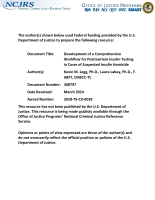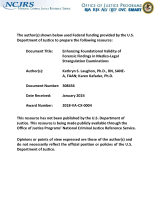Medicolegal death investigations
Current Concepts: Body Farm and Benefits to Law Enforcement
New Screening Method to Detect Drugs and Poisons Postmortem
Providing Forensics Training to Rural Jurisdictions - NIJ National Center on Forensics (NCF)
Well-trained forensics specialists are integral to ensuring justice across the United States. However, in the country's rural states and locations, this training can be hard to come by.
The National Center on Forensics (NCF) is a partnership between George Mason University, the National Association of Attorneys General, the American Society for Clinical Pathology, and the Montana Forensic Science Division funded by the National Institute of Justice. This grant program aims to bring forensics training to the nation's underserved rural areas.
See the YouTube Terms of Service and Google Privacy Policy




